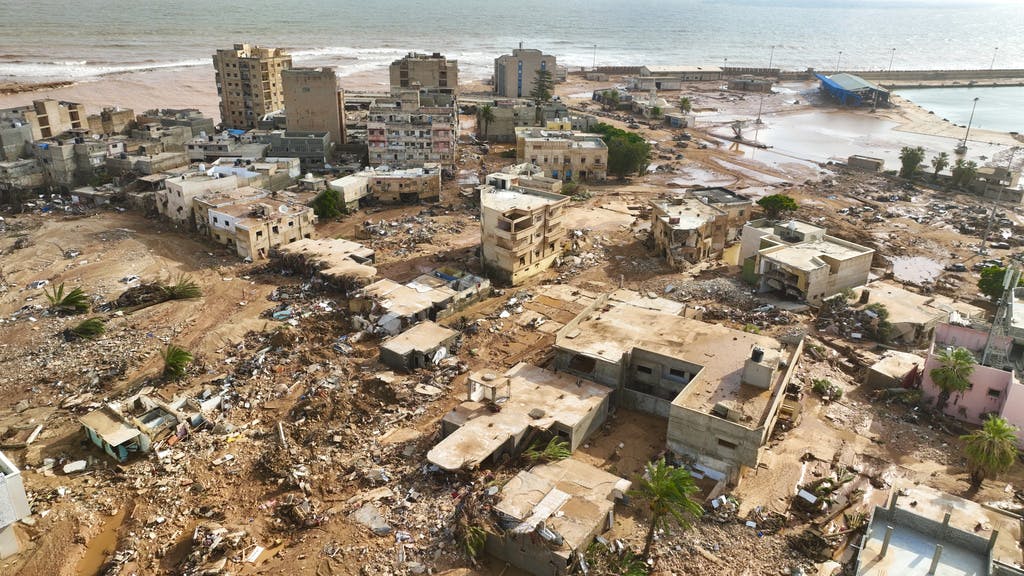Libya’s Chaotic State Leaves It Vulnerable to Worst Flooding in Its Modern History
Death toll could exceed 5,000, officials fear, in the country made vulnerable by years of turmoil.

In a cruel twist of fate, a summer that saw deadly wildfires scorch portions of various Mediterranean countries ended with a storm that turned Greece’s broad Thessalian plain into a lake and then brought unprecedented flooding to a vast swath of northern Libya.
A storm that has already killed thousands of people and left thousands more missing in Libya is the latest blow to a country that has been gutted by years of chaos and division.
The floods are the environmental disaster that caused the most fatalities in the country’s modern history. Years of war and lack of a central government have left it with crumbling infrastructure that was vulnerable to the intense rains.
The north African country has been divided between rival administrations and beset by militia conflict since the NATO-backed Arab Spring uprising toppled its autocratic ruler, Moammar Gadhafi, in 2011.
The city of Derna in the country’s east saw the most destruction, as large swaths of riverside buildings vanished, washed away after two dams burst. More than 2,000 corpses were collected as of Wednesday morning and more than half of them had been buried in mass graves at Derna, eastern Libya’s health minister, Othman Abduljaleel, said.
Much of Derna was constructed when Libya was under Italian occupation in the first half of the 20th century. It became famous for its scenic white beachfront houses and palm gardens.
In the aftermath of Gaddafi’s ouster in 2011, it disintegrated into a hub for Islamist extremist groups, was bombarded by Egyptian airstrikes, and was later besieged by forces loyal to a powerful military commander, Khalifa Haftar. The city was taken by Mr. Haftar’s forces in 2019.
Videos of the floods’ aftermath show water gushing through the port city’s remaining tower blocks and overturned cars, and later, bodies covered with blankets lined up on sidewalks, collected for burial. Residents say the only indication of danger was the loud sound of the dams cracking, with no warning system or evacuation plan.
Since 201, Libya has been split between two rival governments, each backed by international patrons and numerous armed militias on the ground.
At Tripoli, Prime Minister Dbeibah heads Libya’s internationally recognized government. But at Benghazi, the rival prime minister, Ossama Hamad, heads the eastern administration, which is backed by Mr. Haftar.
Both governments and the eastern commander have separately pledged to help the rescue efforts in the flood-affected areas, but they have no record of successful cooperation.
Rival parliaments have for years failed to unify despite international pressure, including planned elections in 2021 that were never held.
As recent as 2020, the two sides were in an all-out war. Mr. Hafter’s forces besieged Tripoli in a year-long failed military campaign to try to capture the capital, killing thousands. Then, in 2022, the former eastern leader, Fathi Basagah, tried to seat his government at Tripoli before clashes between rival militias forced him to withdraw.
The support of regional and world powers has further entrenched the divisions. Mr. Haftar’s forces are backed by Egypt, Russia, Jordan, and the United Arab Emirates, while the west Libya administration is backed by Turkey, Qatar, and Italy.
The UAE, Egypt, and Turkey are all helping rescue efforts on the ground. But as of Tuesday, rescue operations were struggling to reach Derna.
A senior Libya analyst at International Crisis Group, Claudia Gazzini, says the problem is partially logistical with many of the roads entering the port city having been severed by the storm. But political strife also plays a role.
“International efforts to send rescue teams have to go through the Tripoli-based government,” Ms. Gazzini said. That means permissions to allow aid inside the most affected areas have to be approved by rival authorities.
She was skeptical the Benghazi government could manage the problem alone, she said.
The flooding follows a long line of problems born from the country’s lawlessness.
Last month, protests broke out across Libya after news broke of a secret meeting between the Libyan and Israeli foreign ministers. The demonstrations turned into a movement calling for Mr. Dbeibeh to resign.
Earlier in August, sporadic fighting broke out between two rival militia forces in the capital, killing at least 45 people, a reminder of the influence rogue armed groups wield across Libya.
Libya has become a major transit point for Middle Eastern and African migrants fleeing conflict and poverty to seek a better life in Europe. Militias and human traffickers have benefited from the instability in Libya, smuggling migrants across borders from six nations, including Egypt, Algeria, and Sudan.
Meanwhile, Libya’s rich oil reserves have done little to help its population. The production of crude oil, Libya’s most valued export, has at times slowed to a trickle due to blockades and security threats to companies. Allocation of oil revenues has become a key point of disagreement.
In the weeks ahead, though, more attention will be focused on water than oil.
A spokesman for the east Libya interior ministry, Mohammed Abu-Lamousha, on Tuesday put the death tally in Derna at more than 5,300, according to the state-run news agency, and that number is expected to rise significantly. Dozens of others were reported dead in other towns in eastern Libya, he said.
